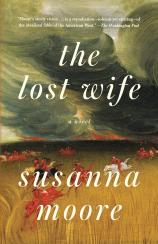The Lost Wife
Review
The Lost Wife
There is no fable we like quite as much as the fable of a woman of low birth who endures hard times, perseveres and triumphs. The first half of Susanna Moore’s 10th book seems to be in that increasingly discredited tradition. Beware.
Moore’s unnamed narrator’s husband has burned her with the soldering flame, and she’s had enough, so she pretends to be asleep until he leaves the room. She packs her few possessions --- a penknife, a dress, a salami, a moth-eaten tartan cape, and two precious letters from her friend, Maddie --- into a cardboard suitcase and flees. It is June 1855, and she’s on her way to Shakopee, Minnesota, where Maddie now lives, to get “work you wouldn’t be ashamed to do.”
"It will cost you some pain to read this novel. But if your reaction is like mine, you’ll make a connection between eye-opening pain and personal growth, and you’ll be glad you read it."
How does she feel? “Excited and exhausted, calm and distressed.” She sees “how easily a new life may be made.” She is 25 years old and 1,000 miles from home, or “what once was home.”
What really is home is her friendship with Maddie, who she met in an asylum for the insane and indigent. She and her mother were making do there, which meant her mother sleeping with men and sometimes women. Someone reported her mother, and they were thrown out. Her mother disappeared. And now, so has Maddie --- disappeared into death.
She gets a job; gives herself a name, Sarah Brown; invents a family history; and proposes marriage to the local doctor, John L. Brinton, who is 40 years old and a Yale graduate, “a very tall, clean-shaven, almost handsome gentleman.” He agrees. Why? “That will always be a mystery.”
It is now May 1862. Sarah’s husband becomes the resident doctor at the Indian agency in Yellow Mountain, caring for the Sioux on the nearby reservation. She has a life of ease --- “warm in the winter, never hungry, with the luxury of a bathtub and a clean privy. I have servants. I’m gentry now. Who would have thought it.”
We’re on page 47 of a 192-page book, exactly when you sense the good life is about to end. You know why: Indians. (That’s what they were called then; it would be correct, but silly, to call them Native Americans here.) In July 1862, the Dakota are told not to come to the agency --- their yearly annuity is delayed. Five thousand Dakota gather in the valley to beg for food. They’re given just enough for a week. They’re enraged.
I loathe “trigger warnings.” Books are often disturbing. So what? Are readers so fragile that every book has to give them a needed escape from life’s complexities and difficulties? Still, I feel I should alert you that the second half of THE LOST WIFE is brutal. Under threat from the Army for insubordination, Sarah gives flour and meat and vegetables to the women. Her husband works through the night, treating Indian children. But rage feeds on itself, and…
A surprise: From here, this is close to the story of Sarah F. Wakefield, who published SIX WEEKS IN THE SIOUX TEEPEES: A Narrative of Indian Captivity in 1864. Moore’s take is thoroughly contemporary, and that, I think, is why the story appealed to her. She writes, “It matters little what crimes have been committed against the Dakota; this uprising will always be thought more horrific than anything the whites have done to them.”
And what have the whites done? An old story: they stole money intended for the Dakota. The superintendent of Indian affairs took $65,000. His secretary skimmed $55,000. A General awarded himself $145,000 of one year’s annuity, “which he claimed was owed him for his part in negotiating the treaty.”
What, in comparison, were Sarah’s crimes? To save herself and her children, she rubs mud on her skin and abandons Western clothes. She falls in silent, unspoken love with an Indian she had helped in happier times.
What does Sarah witness with her new Dakota eyes? What does she feel when white soldiers put down the rebellion and slaughter the Dakota? And what does she tell her husband when they’re reunited?
This is history reimagined, the way it may have really been --- troublesome and painful. It must have cost Susanna Moore a great deal to look unflinchingly at a woman’s life at a time when that woman was never more alone. It will cost you some pain to read this novel. But if your reaction is like mine, you’ll make a connection between eye-opening pain and personal growth, and you’ll be glad you read it.
Reviewed by Jesse Kornbluth for HeadButler.com on April 22, 2023
The Lost Wife
- Publication Date: August 20, 2024
- Genres: Fiction, Historical Fiction, Women's Fiction
- Paperback: 192 pages
- Publisher: Vintage
- ISBN-10: 0345807308
- ISBN-13: 9780345807304




